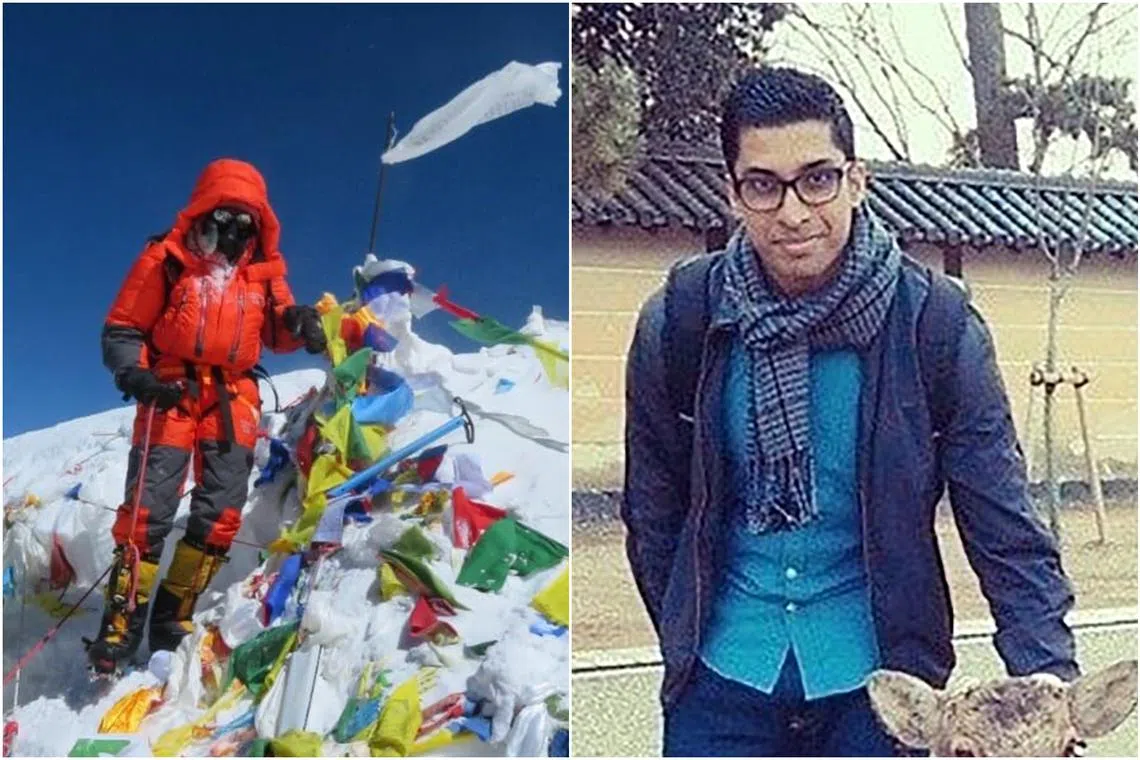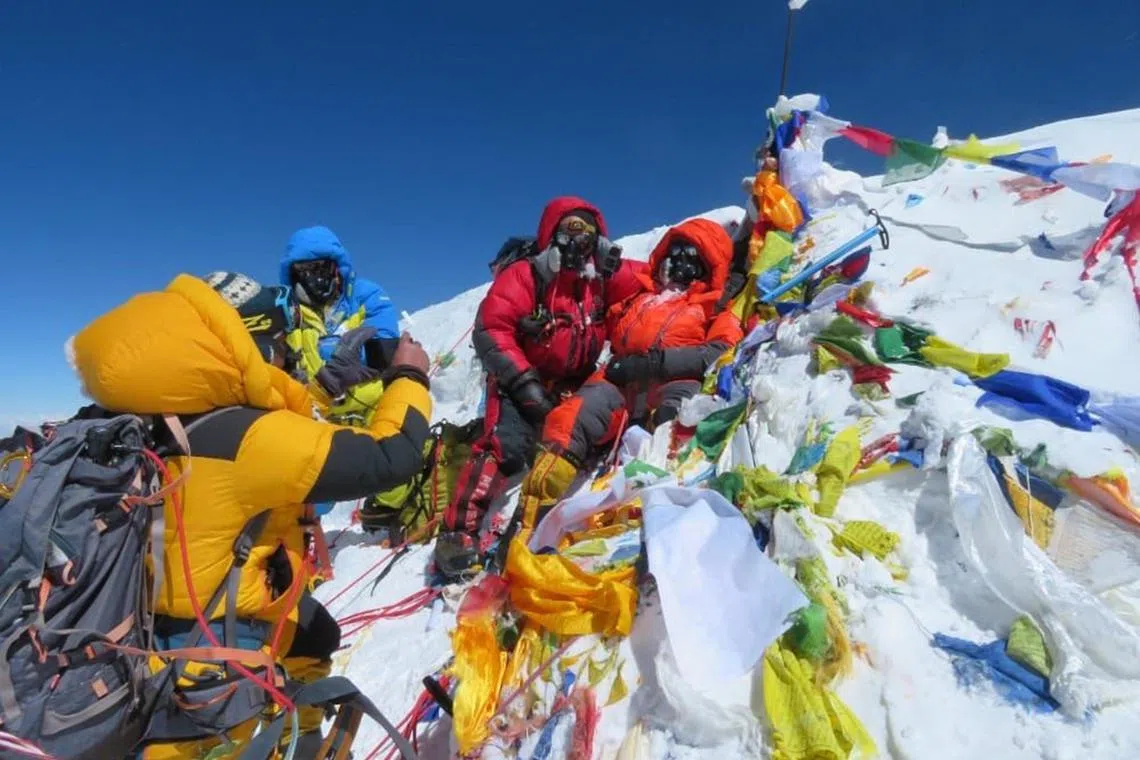S’porean missing on Everest an experienced climber: Expedition organiser
Sign up now: Get ST's newsletters delivered to your inbox

Singaporean climber Shrinivas Sainis Dattatraya at the Mount Everest summit on May 19. He went missing soon after.
PHOTOS: PRAKASH CHANDRA DEVKOTA, CHANGE.ORG
Follow topic:
SINGAPORE – A search and rescue operation involving several teams is under way for a missing Singaporean climber who had reached Mount Everest’s summit,
Mr Shrinivas Sainis Dattatraya’s family members have also gone to Nepal to meet the rescue teams, added Mr Prakash Chandra Devkota, the owner of Nepal Guide Treks and Expedition.
His company and Seven Summit Treks, a Nepal-based adventure travel operator, organised Mr Shrinivas’ Everest ascent.
Mr Devkota told The Straits Times on Monday that teams consisting of three Sherpas each have been searching for the 39-year-old.
He also shared photos of the climber reaching the summit last Friday before he went missing.
In the photos, Mr Shrinivas, a senior manager for software engineering at real estate tech firm JLL Technologies, is wearing bright orange winter wear, sunglasses and an oxygen mask, surrounded by colourful prayer flags marking the 8,849m summit.
He is clutching a rope with his right hand, and stands upright on the peak.
In another picture, Mr Shrinivas lies on his back, surrounded by three others in similar mountain climbing wear. One of them snaps a shot of him with a smartphone.
ST had reported last week that, using his satellite phone, Mr Shrinivas last sent a text message to his wife Sushma Soma, 36, on Friday, saying he had reached Everest’s summit.
But he told her he had high-altitude cerebral edema, a severe type of high-altitude illness that could prove fatal, and was not likely to make it back down.
Madam Soma, a musician, learnt at 2am on Saturday that the two Sherpas he was with, and another climber in the group, had made it down from the mountain, but her husband never did.
In a 90-second video, seen by ST, the other climber described how they came down the mountain.
The man in a black T-shirt, whom the speaker off-camera referred to as “Martin”, said the group reached the summit at around 9am.
The man said he was alone, while Mr Shrivinas was with the two Sherpas.
He said he had run down to wait at Camp Four, the final camp before mountaineers reach the summit. The video does not reveal more information.
Mr Devkota said one of the Sherpas, Mr Dendi, had tried to save Mr Shrinivas, but he did not give more details.
He said Mr Dendi had suffered frostbite to his fingers and was hospitalised.

Mr Dendi, one of the Sherpas who accompanied Mr Shrinivas Sainis Dattatraya, was hospitalised due to frostbite on his fingers.
PHOTO: PRAKASH CHANDRA DEVKOTA
Mr Devkota said his company hired the Sherpas for this expedition, while Seven Summit Treks handled the logistics. The latter did not respond to ST’s requests for comment.
Mr Devkota said Mr Shrinivas was his good friend and had joined them on previous climbs, including a 2021 expedition to the 8,163m Manaslu peak in Nepal, but “this time is so bad”. He did not elaborate further when asked what had happened.
In an Instagram story on Monday, Madam Soma said the search and rescue mission was ongoing, adding: “Thank you all for all your (messages). We are grateful for your love and concern.”
At least 11 climbers have died so far
Two Singaporean climbers who have been to Everest said they did not know Mr Shrinivas personally and did not want to speculate on what might have happened.

Nepal Guide Treks and Expedition owner Prakash Chandra Devkota shared photos of Mr Shrinivas Sainis Dattatraya (right) surrounded by three other people.
PHOTO: PRAKASH CHANDRA DEVKOTA
Ms Sim Phei Sunn, 47, a public servant, reached the summit in May 2019. She recalled seeing bodies there.
She said that the mountaineering community has noticed more inexperienced climbers on Everest, which might have contributed to the higher death toll.
Recalling her 2019 expedition, she said: “You can see people wearing their helmets the wrong way, and putting their crampons (spikes attached to climbing boots) on the wrong feet, which shows they shouldn’t be there.”
She said established companies usually screen climbers before planning an expedition by looking at their climbing record.
This includes the mountains they have scaled, which sports they do and their overall fitness level.
But she said that in recent years, more low-cost operators have entered the market, and they are unlikely to turn away inexperienced clients.
Ms Sim recommends hopefuls to spend a few years scaling 6,000m to 8,000m mountains as well as training in different terrain, including in alpine conditions with ice and snow.
She said: “You train before you go to Everest; you don’t go to Everest to train.”
Mr David Lim, leader of the first Singapore Mount Everest expedition in 1998, said that based on Mr Shrinivas’ Facebook page, he had good experience with mountain climbing.
He said: “It seems he did quite a lot of high-altitude mountaineering in the last five or six years. And he seems to have had a very sensible progression and plan, successively climbing higher mountains... before tackling Everest. But these things can happen to the best of us too.”
Mr Lim said his 1998 expedition cost $790,000. Half of it was sponsored.
He said he did not make it to the top as he suffered a rib injury.
Mr Lim, who tried to reach the summit once more in 2001 but did not make it, added: “Climbing is a two-way journey. Getting to the top is optional, but getting down is mandatory.”

